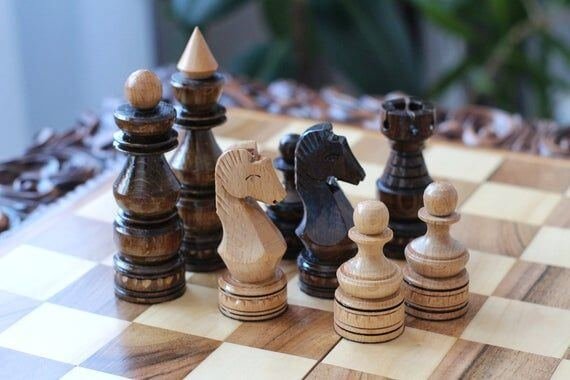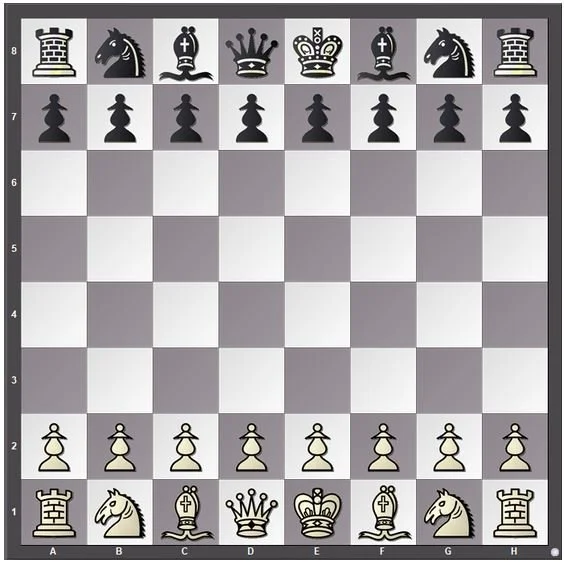EXPLAINED: Chess Piece Names and How They Move
The 6 Different Chess Pieces and How They Move on the Board
Starting out in chess can feel intimidating at first.
However, the pieces themselves are very simple and once you begin to learn how they move, the game comes together very quickly.
Different chess pieces on the board
There are only six pieces in chess: The pawn, the knight, the bishop, the rook, the queen and the king.
Each piece moves differently and is valued at different levels. In this article, read about the different chess pieces and how they move across the board.
Let’s start with pawns, the soul of chess.
What is the pawn?
Key Characteristics
Can move 2 squares in a straight line on the first love only
Can only move one square forward after the first move
Takes other pieces one square diagonally
The pawn is the metaphorical foot soldier of the war that occurs on the chessboard.
The word “pawn” originally comes from the word “soldier” and it is the same across most languages, except for some cultures where the word for farmer or peasant is used.
The pawn can move one square forward on every turn, except for its first move, where it can move two squares forward.
The pawn is the only piece in chess that cannot move backwards and the only piece that captures differently than it moves.
The pawn captures diagonally, one square. Meaning if there is a white pawn on e4 and a black pawn on d5, those pawns can capture each other.
On the other hand, if there is a white pawn on e4 and a black pawn on e5, those pawns will never capture each other.
They will remain opposed the whole time, not moving unless another piece approaches a diagonal so one pawn can capture.
If you want to learn more about pawns, check out our article on pawn structures.
What is the knight?
Key Characteristics
Moves in an ‘L’ shape - 2 squares in any direction and one to the right or left
Can be used to ‘fork’ 2 opposing pieces
The knight is the trickiest piece in chess.
Like the pawn, it is very unique because it is the only piece that can jump over other pieces.
It moves in an L-shape, meaning two squares horizontally and one square vertically or vice-versa.
The knight was originally called a horse in Chaturanga, the game that preceded chess.
In several languages it is still called a horse, but in English, it’s called a knight. This is because the board was seen as a royal court, and not a battlefield.
Interestingly, in German, the knight is called a jumper, which more closely represents how it moves.
Tricky players prefer the knight to its minor piece counterpart, the bishop, because of how it moves.
Its unique L-shaped movement and the ability to jump around helps tricky players find forks in complicated positions.
What is the bishop?
Key Characteristics
Moves diagonally and is often useful at long range
A great ‘pinning’ piece
The bishop is a long-range threat, with little mobility.
The bishop can move diagonally any number of squares.
Unlike the knight, which excels in closed positions, jumping around and finding valuable outposts, the bishop likes open positions, where it can sit safely on a long diagonal and control a lot of the board.
The bishop comes from the Indian word “Hasty” or “Gaja”, which translates to Elephant.
As Arab chess came to Europe, the word for the piece had lost its original meaning and people were looking for words in their own language that would be similar.
Italians called the bishop their word for flag-bearer, while several languages used the word for “fool.”
The English, seeing the two tusks on the elephant piece, assumed them to be the Bishop’s miter, and, as that fit with their idea of a royal court, it became their word for the piece.
What is the rook?
Key Characteristics
Moves only horizontally and vertically
Powerful in the end game
The rook is considered stronger than the bishop or knight, but slightly weaker than a bishop and knight together.
It can move infinitely vertically or horizontally, but not diagonally.
The rook also takes part in the action of “castling” where the king moves two squares horizontally from its starting square toward the rook and the rook moves to the opposite side of the king.
This can happen on the kingside or queenside as long as the king hasn’t moved and there aren’t any pieces threatening the squares where the king would move through to castle.
The rook was originally named after the word for chariot, which later became “rukh” in Persian.
As the game came to Europe, the name became “rocco”, which sounds similar to the Italian word “rocca”, meaning fortress.
Because of this, it became known as a tower or fortress in several European countries.
The English word “Rook” is a transliteration of “rukh” in Persian, but it’s still seen as a tower in English-speaking countries.
The rook becomes very strong in the endgame as it can start to support the pushed pawns.
The rook is powerful when it can get in front of the pawns or if it has pawns pushed far up the board.
In the beginning, as it’s stuck behind the pawns, it serves as a bad defensive piece.
What is the queen?
Key Characteristics
Can move in all directions for an unlimited number of squares
Is the most valuable piece on the board - worth ‘9 points’
The queen is the most powerful piece in chess!
It can move infinitely in any direction: vertically, horizontally or diagonally.
The word for queen comes from the Persian word “ferz”, which means councillor. This became the word, “fercia” and later “feirge.”
With similarity of the word “fierge” to the French word “vierge”, which means “virgin” or “maiden”, people assumed this meant the Virgin Mary.
This led to people calling the queen names for maiden or lady in several different languages.
Finally, its position near the king and its relation to the Virgin Mary led to it being called a queen by several countries.
The queen’s mobility and control of the board are unmatched. In both positional and attacking positions, the queen has the most impact on the board.
This makes it a piece to be protected unless there is a checkmate or some combination of other pieces to be won.
In general, two rooks or two minor pieces and a rook can be worth the same as a queen.
What is the king?
Key Characteristics
Can move one square in any direction
Should start moving the King early in the end-game
The king is the leader of the metaphorical army and the piece whose capture determines the winner of the game.
In fact, “Checkmate” means that the king will be captured on the next move and there is nothing the opponent can do to stop it.
The king moves one square in any direction: vertically, horizontally or diagonally. It also takes part in the “castling” action mentioned earlier.
Unlike most other pieces mentioned, the king has very little diversity in its naming across the world. In nearly every language, the king is called a king.
The word “checkmate” actually comes from the Persian phrase “Shah mat,” which means “the king is dead.”
Early in the game, it is incredibly weak and should be protected heavily.
Later on, with more pieces traded, the king becomes a useful piece in supporting pushed pawns or lone minor pieces.
Setting up the board
The chessboard is set up with 8 pawns along the 2nd and 7th ranks and all other pieces on the 1st and 8th ranks.
From the outside in, the pieces are set up as follows: rooks, knights, bishops and, finally, the king and queen.
The queen should always be set up on its own colour, which means for white, it will be on the left, and for black, it will be on the right.
This is how to setup a Chess Board
Now that you know how to set up the board and how the pieces move, check out our 10 chess tips for beginners or some aggressive openings to try out!


